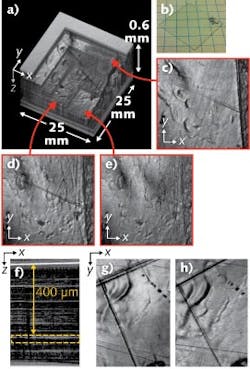A group at the University of Rochester (U of R; Rochester, NY), in collaboration with a number of other institutions, is using optical coherence tomography (OCT) to get high-resolution 3D images of the internal structure of a new form of gradient-index (GRIN) lens.1 Called the S-GRIN, the new lens has a spherical refractive-index gradient; the breakthrough in the lens itself is that it is manufacturable, leading to potential uses for lightweight single-lens cameras and other devices. The U of R team includes researchers from Synopsys (Pittsford, NY), PolymerPlus (Valley View, OH) Case Western Reserve University (Cleveland, OH), and Suranaree University of Technology (Nakhon Ratchasima, Thailand).
While GRIN lenses with axial gradients (and curved surfaces) and especially those with radial gradients (often rod-shaped with flat ends normal to the optical axis) are common, S-GRIN lenses are less so, due to the difficulty of fabricating a spherical index gradient. But because such a gradient gives lens designers additional freedom to correct lens aberrations, perseverance by researchers at Case Western Reserve University has resulted in a manufacturing technique in which many polymer layers are laid down on one another. Next, they are heated, compressed, and formed into a preform with spherical concentric surfaces; the preform can then be diamond-turned to create a final lens.2
3D imaging in microscopic detail
But an important part of the lens-manufacturing process is knowing the detailed characteristics of what is being made. Because OCT allows noninvasive 3D measurement of the internals of a light-transmitting substance (the most well-known use of OCT is to create 3D images of biological tissue), the U of R researchers adapted it so that they could image the many layers of an S-GRIN in microscopic detail.
Two approaches were taken. One, developed at the U of R, is called Gabor-domain-optical coherence microscopy (GD-OCM), and delivers a high resolution of 2 μm in three dimensions over an 8 mm cubic volume.
“With this technology, we imaged at high sensitivity individual films as well as stacks of films over 0.6 mm thick,” says U of R researcher Jannick Rolland. “At the same composition of the layers, but under different temperatures during the assembly of a stack, different levels of clarity of the films were observed.” In addition, says Rolland, backscattering between layers was lowered through a new process for layering called compatibilization; the process also helped boost the transmission through the optical component by more than 10% compared to the original process.
The second OCT process is swept-source Fourier-domain OCT (SS-OCT), which provides 8 μm axial resolution and 20 μm lateral resolution. SS-OCT can measure up to 5 mm deep and is used to characterize the whole volume of GRIN sheets (see figure), with GD-OCM used on a finer scale to capture microscopic structures in detail. “As the layers are assembled together, possible departures from the ideal layering may be that some of the layers are under- or over-compressed compared to expectations,” says Rolland. “[Using SS-OCT] we were able to quantify these departures, and the manufacturing process was iterated to correct for those.”
Rolland and her team are collaborating with Michael Ponting from PolymerPlus, who is developing the manufacturing process for the S-GRIN lens. The feedback offered by OCT has allowed S-GRINs to be improved significantly.
“OCT is a very sensitive technique that shows subtle structures with high contrast,” notes Rolland. “The key is to correlate these apparent structures to how they may deform wavefronts passing these components. Our understanding of the impact of the remaining structures will be deepened in future investigations of combined OCT and conventional interferometry. To date, we have analyzed samples that satisfy the diffraction limit across 90% of the aperture.”
REFERENCES
1. P. Meemon et al., Sci. Rep., 3, 1709 (2013); doi:10.1038/srep01709.
2. Y. Jin et al., J. Appl. Poly. Sci., 103, 1834–1841 (2007).

